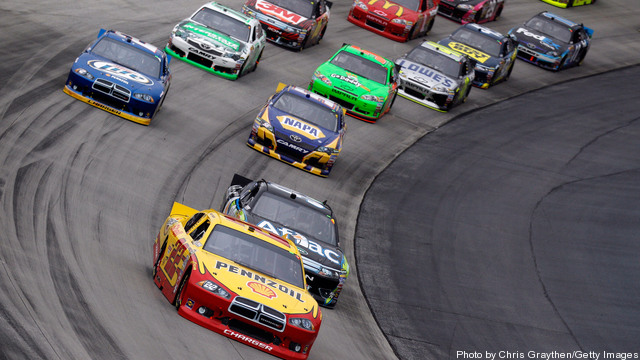NASCAR racing team owner Richard Childress has an op-ed in the Charlotte Observer this week in which he renders a full-throttle endorsement of E15 gasoline and the Renewable Fuel Standard (RFS), the federal program that requires more and more ethanol be blended into the nation’s fuel supply.
Childress focuses on the specially formulated E15 (98 octane rating, compared to 90 octane in retail E15) that NASCAR uses in its customized, high-performance engines (725 horsepower, compared to 120 horsepower in a typical car engine, up to 200 horsepower in a large SUV).
Certainly, NASCAR racecars and the NASCAR-blend E15 are well-suited for each other. Less clear is why Childress is so enthusiastic about putting commercial-grade E15 in a car or truck, especially those built between 2001 and 2013 – something most car manufacturers don’t recommend:

And of course, that’s one of the main touch points in the current E15/RFS debate – the safety of using higher ethanol-blend fuels in the millions of vehicles on the road today that weren’t designed to use it, with research showing that E15 could damage engines and fuel systems. That risk for consumers and a fundamental disagreement over the role of government in managing market and consumer behavior (which is happening with the command-and-control ethanol mandates of the RFS) are primary issues.
That NASCAR racecars use NASCAR’s special E15 racing fuel is largely irrelevant in the larger RFS discussion, because the vast majority of Americans don’t drive racecars, don’t have multiple-member crews to care for their vehicles and don’t have access to measures to safely use E15 – as described by Sunoco:
This specialized NASCAR® fuel also contains 15% ethanol by weight, making it very important for teams to avoid getting moisture into their fuel filler cans or racecar fuel cells. We made a number of innovations to make sure moisture never mixes with the fuel, including distribution directly from the Sunoco tanker (instead of in-ground tanks), and newly designed NASCAR® fuel cans.
All of that said, there are a few other assertions in Childress’ op-ed that merit comment.
Oil imports – Childress writes: “Renewable fuel has reduced our dangerous dependence on foreign oil by nearly two thirds.” The facts say otherwise. As we’ve a noted before, falling net crude oil imports are largely the result of increased domestic oil production:

What you see in the chart above is that while ethanol production increased from 2008 to 2014 (yellow), the amount of the increase is a fraction of the increase in domestic oil production (blue). That increased domestic output more than accounts for the decrease in net crude imports over the same period (red). It’s false to credit ethanol production increases with a significant role in reducing America’s imports.
Climate – Childress lauds the RFS for improving America’s “climate security.” A number of folks disagree. The Environmental Working Group’s report, “Ethanol’s Broken Promise,” raises serious questions about the claimed environmental benefits of corn-based ethanol, pointing out the millions of acres of grassland and wetlands converted to corn and the annual greenhouse gas emissions stemming from ethanol production:
In light of these emissions, many scientists now question the environmental benefit of so-called biofuels produced by converting food crops. A few recent studies still claim that corn ethanol produces fewer emissions than gasoline, but a careful look reveals that their methods don’t properly account for land use change. Studies that do factor in land use change show that using food crops to produce biofuels – once considered a promising climate change mitigation strategy – is worse for the climate than gasoline.
Converting new land for agriculture actually causes extra carbon emissions and can lead to deforestation and the loss of biodiversity and wetlands.
A University of Minnesota research team found that:
Although corn ethanol as modeled here emits marginally less GHGs than does gasoline, the combined climate and air quality impacts are greater than those from gasoline vehicles. … Other fuels, such as corn ethanol [the climate impact of which is unclear], are more damaging than conventional vehicles when air pollution impacts are considered alone or when air pollution and climate impacts are considered together.
Policy – Childress calls “mythical” the ethanol blend wall – the point where, because of RFS mandates, refiners must blend more ethanol into the fuel supply than can be safely absorbed as standard E10 gasoline. The blend wall is real, which EPA acknowledged in a draft proposal that would adjust ethanol use requirements to avoid hitting it. Ethanol producers argue that the RFS’ mandates can be satisfied by producing higher ethanol blends, like E15 and E85. We’ve noted issues with E15, and E85. The latter, which hasn’t been a hit with consumers because it won’t take them as far as a tank of E10, isn’t the answer, either.
The answer is repeal or significant overhaul of the RFS, an outdated, counterproductive program whose ethanol mandates could harm consumers and the larger economy.
Saturday will be the 10th anniversary of the law that created the RFS. Let’s hope it’s the RFS’ last birthday, with Congress moving in a way that recognizes market realities and protects the interests of consumers instead of ethanol interests.
By Mark Green
Originally posted August 7, 2015
Energy Tomorrow is brought to you by the American Petroleum Institute (API), which is the only national trade association that represents all aspects of America’s oil and natural gas industry. Our more than 500 corporate members, from the largest major oil company to the smallest of independents, come from all segments of the industry. They are producers, refiners, suppliers, pipeline operators and marine transporters, as well as service and supply companies that support all segments of the industry.


